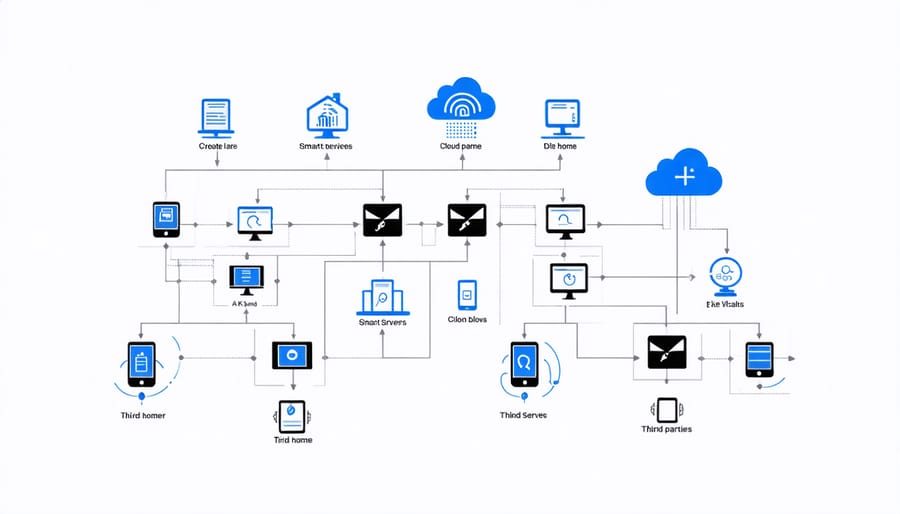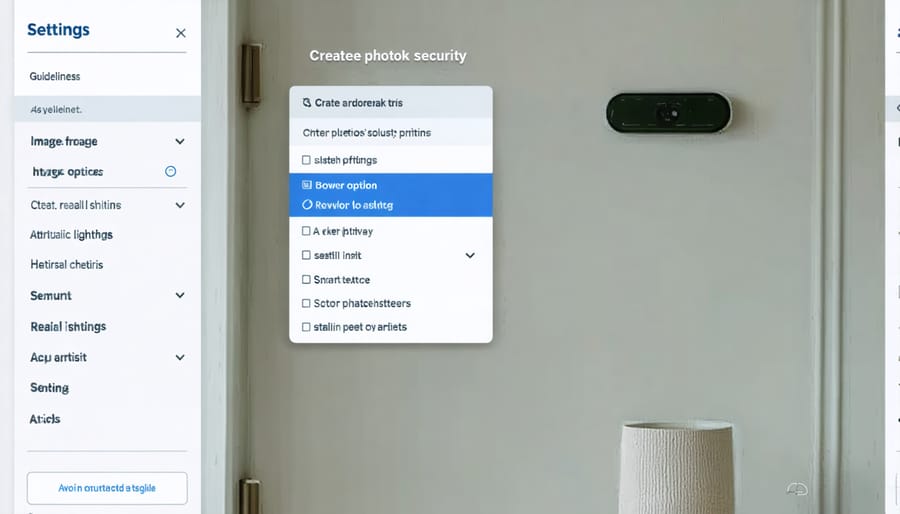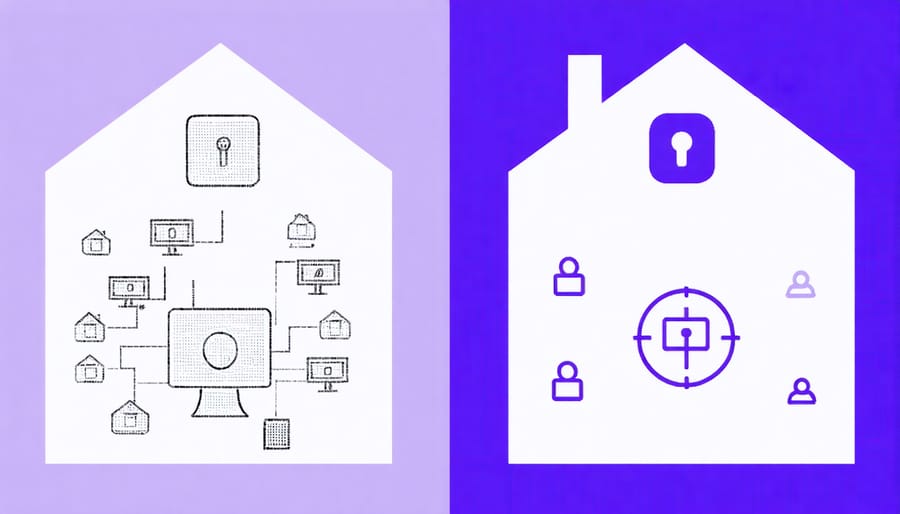Smart home devices offer unprecedented convenience, but their always-listening microphones, internet-connected cameras, and data collection capabilities create significant privacy vulnerabilities. Recent studies show that 79% of smart home users have experienced at least one privacy breach, ranging from unauthorized data access to targeted advertising based on recorded conversations.
To effectively protect your connected home, understanding these risks is crucial. Smart speakers may inadvertently record private conversations, security cameras could be compromised by hackers, and seemingly innocent data like your thermostat settings can reveal detailed patterns about your daily routine.
The good news? You don’t have to choose between modern convenience and privacy. By implementing proper security measures and staying informed about potential vulnerabilities, you can enjoy the benefits of smart home technology while maintaining control over your personal information. This guide will walk you through practical steps to secure your smart home ecosystem without sacrificing the convenience that made these devices appealing in the first place.
Let’s explore how to safeguard your privacy while keeping your home both smart and secure.
The Hidden Privacy Risks in Your Smart Home Security

Data Collection and Storage Concerns
Smart homes collect an impressive amount of data to make our lives more convenient, but it’s essential to understand what information is being gathered and how it’s being stored. Your smart devices track everything from daily routines and temperature preferences to voice commands and even advanced security features like facial recognition.
Most smart home devices store data both locally and in the cloud. While local storage might seem safer, cloud storage often provides better security through encryption and regular updates. However, this means your personal information travels through various networks and servers, potentially exposing it to unauthorized access.
The types of data collected typically include:
– Usage patterns and schedules
– Temperature and lighting preferences
– Voice recordings and commands
– Video footage from security cameras
– Energy consumption metrics
– Location data when you’re away from home
The main risks associated with this data collection include potential breaches, unauthorized access, and data sharing with third parties. Some companies may use your information for targeted advertising or sell it to other businesses. Additionally, hackers could potentially access your stored data to learn when you’re away from home or gather other sensitive information about your daily habits.
To minimize these risks, regularly review your devices’ privacy settings, understand their data collection policies, and choose products from reputable manufacturers with strong security track records.
Third-Party Access and Data Sharing
When you welcome smart devices into your home, you’re not just sharing your data with the manufacturer – you’re potentially opening doors to a network of third-party companies. Many smart home companies partner with data analytics firms, advertisers, and other service providers who may receive portions of your personal information.
The reality is that your smart doorbell might be telling advertisers when you’re home, while your smart speaker could be sharing your voice commands with AI training companies. Most companies outline these data-sharing practices in their privacy policies, but let’s be honest – how many of us actually read those lengthy documents?
To protect yourself, start by reviewing the privacy settings for each of your devices. Look specifically for options to limit data sharing with third parties and opt out of “marketing partnerships” whenever possible. Before purchasing new smart home devices, compare different manufacturers’ data-sharing policies and choose those with more restrictive practices.
It’s also worth noting that law enforcement agencies may request access to your smart home data. While companies generally require proper legal documentation before sharing information, it’s important to understand that your smart home data could potentially be used in investigations.
Remember to regularly audit which apps and services have access to your smart home devices, and revoke permissions for those you no longer use or trust.
Practical Steps to Secure Your Smart Home System
Securing Your Network
Your home network is the foundation of your smart home security, and taking steps to secure your home network is essential for protecting your privacy. Start by changing your router’s default password to a strong, unique combination of letters, numbers, and symbols. Enable WPA3 encryption if your router supports it, or at minimum, use WPA2.
Create a separate guest network for your smart devices to keep them isolated from your main network where you handle sensitive information. This way, if one device is compromised, your personal data remains protected. Remember to regularly update your router’s firmware and all connected devices to patch security vulnerabilities.
Choose unique passwords for each of your smart devices, and enable two-factor authentication whenever possible. Consider using a password manager to keep track of these credentials securely. Disable any features you don’t use, such as remote access or voice controls, as each active feature is a potential entry point for attackers.
Review and adjust the privacy settings on all your smart devices. Many come with default settings that prioritize convenience over security. Check what data they’re collecting and sharing, and opt out of unnecessary data collection. If a device doesn’t offer adequate privacy controls, consider replacing it with a more security-focused alternative.
Finally, maintain an inventory of all connected devices and regularly audit their access permissions. Remove any devices you no longer use and reset those you plan to sell or dispose of to factory settings.
Privacy Settings Configuration
Taking control of your smart home privacy starts with proper device configuration. Let’s walk through the essential privacy settings you should adjust on your most common smart home devices.
For smart speakers like Amazon Echo or Google Home, begin by reviewing your voice recording settings. Navigate to your device’s app and disable voice recording storage, or set recordings to auto-delete after a specific period. Consider muting the microphone when you’re having sensitive conversations.
Smart cameras require particular attention. Access your security camera’s settings and enable encryption for all video feeds. Set up two-factor authentication if available, and regularly review and remove old recordings. For indoor cameras, establish privacy zones to block recording in sensitive areas of your home.
With smart thermostats and lighting systems, limit data sharing to only what’s necessary for basic functionality. Disable features like “learning patterns” or “presence detection” if you’re uncomfortable with movement tracking. Remember to regularly check which third-party apps have access to your device data and revoke unnecessary permissions.
For smart doorbell cameras, adjust motion detection zones to avoid capturing your neighbor’s property. Enable privacy shutters or scheduling features during times when you want enhanced privacy. Most importantly, customize notification settings to prevent unnecessary data transmission when you’re home.
Smart hub privacy settings deserve special attention as they often control multiple devices. Create separate user profiles for family members with appropriate access levels, and regularly audit connected devices and their permissions. Enable guest modes when needed instead of sharing primary access credentials.
Remember to:
– Change default passwords on all devices
– Regularly update device firmware
– Disable features you don’t actively use
– Review privacy policies when apps update
– Check connected device lists monthly
These small adjustments can significantly enhance your smart home privacy while maintaining the convenience you love.

Regular Security Maintenance
Just like any other home maintenance task, keeping your smart home security system private requires regular attention. Think of it as a digital spring cleaning that protects your family’s privacy. Here’s your essential maintenance checklist to stay secure:
Start by reviewing all your connected devices monthly. Check for any unusual behavior, like devices connecting at odd hours or unfamiliar network activities. Make it a habit to change your passwords every three months, using strong combinations of letters, numbers, and symbols.
Keep your devices’ firmware up-to-date – manufacturers regularly release security patches to protect against new vulnerabilities. Enable automatic updates whenever possible, but manually check for updates monthly just to be safe. Remember to update your router’s firmware too, as it’s your smart home’s first line of defense.
Regularly audit your device permissions and user access. Remove any old devices you no longer use and revoke access for people who don’t need it anymore. Review your privacy settings quarterly to ensure they still align with your comfort level.
Create a monthly schedule to check your security cameras’ viewing angles and ensure they’re not accidentally capturing your neighbors’ property. Also, verify that your smart speakers’ activation zones aren’t picking up conversations from private areas of your home.
Document all your maintenance activities in a simple log. Note when you performed updates, changed passwords, or modified settings. This record helps you stay organized and identifies patterns if security issues arise.
Remember, consistent maintenance is key to maintaining your smart home’s privacy shield. By following these regular checks, you’ll stay one step ahead of potential privacy breaches while enjoying the convenience of your smart home system.
Choosing Privacy-Focused Smart Home Products
Key Privacy Features to Look For
When it comes to choosing the right security system, certain privacy features should be non-negotiable. Look for devices that offer strong encryption protocols, preferably with end-to-end encryption that prevents unauthorized access to your data. Two-factor authentication is another must-have feature, adding an extra layer of security beyond just passwords.
Pay attention to devices that give you granular control over data collection and sharing. The best smart home devices let you decide what information is collected and how it’s used. Some even allow you to store data locally rather than in the cloud, giving you complete control over your information.
Privacy settings should be easily accessible and adjustable. Look for systems that provide clear privacy policies and regular security updates. The ability to delete stored data and customize recording schedules is also crucial for maintaining your privacy.
Voice control features should include mute buttons or physical shutoffs for microphones and cameras. This gives you the power to ensure devices aren’t listening or watching when you want complete privacy. Additionally, consider systems that offer guest access controls, allowing you to share limited access without compromising your main security settings.
Remember to check if the manufacturer has a strong track record of addressing security vulnerabilities and responding to privacy concerns promptly. This shows their commitment to protecting your data long-term.

Red Flags to Watch Out For
When setting up your smart home system, staying alert to these privacy red flags can help protect your personal information. Keep an eye out for devices that require excessive permissions or ask for access to features they don’t need to function. For example, a smart doorbell shouldn’t need access to your phone’s contact list or location data.
Be wary of smart home products that don’t offer two-factor authentication or come with default passwords that can’t be changed. These are major security vulnerabilities that could leave your system exposed to unauthorized access. Similarly, devices that don’t receive regular security updates or come from manufacturers with a poor track record of addressing security concerns should raise immediate concerns.
Watch out for companies that aren’t transparent about their data collection practices or have vague privacy policies. If you can’t easily find information about how your data is stored, used, and shared, that’s a red flag. Be particularly cautious of smart home devices that continue to collect data even when in standby mode or those that don’t allow you to delete your recorded information.
Consider it a warning sign if your smart home system suddenly starts behaving differently, like cameras activating at unusual times or devices connecting to unknown networks. These could indicate a security breach or unauthorized access to your system.
As we’ve explored throughout this article, smart home technology offers incredible convenience and functionality, but it’s crucial to approach it with a balanced perspective on privacy. The good news is that you don’t have to choose between modern conveniences and protecting your personal information – with the right precautions, you can enjoy both.
Remember the key takeaways: regularly update your devices’ security settings, create strong, unique passwords for all your smart home accounts, and carefully review the privacy policies of your device manufacturers. Consider implementing a separate network for your smart devices, and always disable features you don’t actively use.
Think of your smart home privacy like your house itself – you wouldn’t leave your front door unlocked, so don’t leave your digital doors open either. Take time to understand what data your devices collect and how it’s being used. When in doubt, opt for devices from reputable manufacturers with strong track records in privacy protection.
The future of smart home technology is bright, but it’s up to us as consumers to make informed decisions about our privacy. By following the guidelines we’ve discussed, you can create a comfortable, automated home while keeping your personal information secure. After all, a truly smart home is one that’s both convenient and safe.
Stay vigilant, stay informed, and enjoy the benefits of your smart home with peace of mind.
